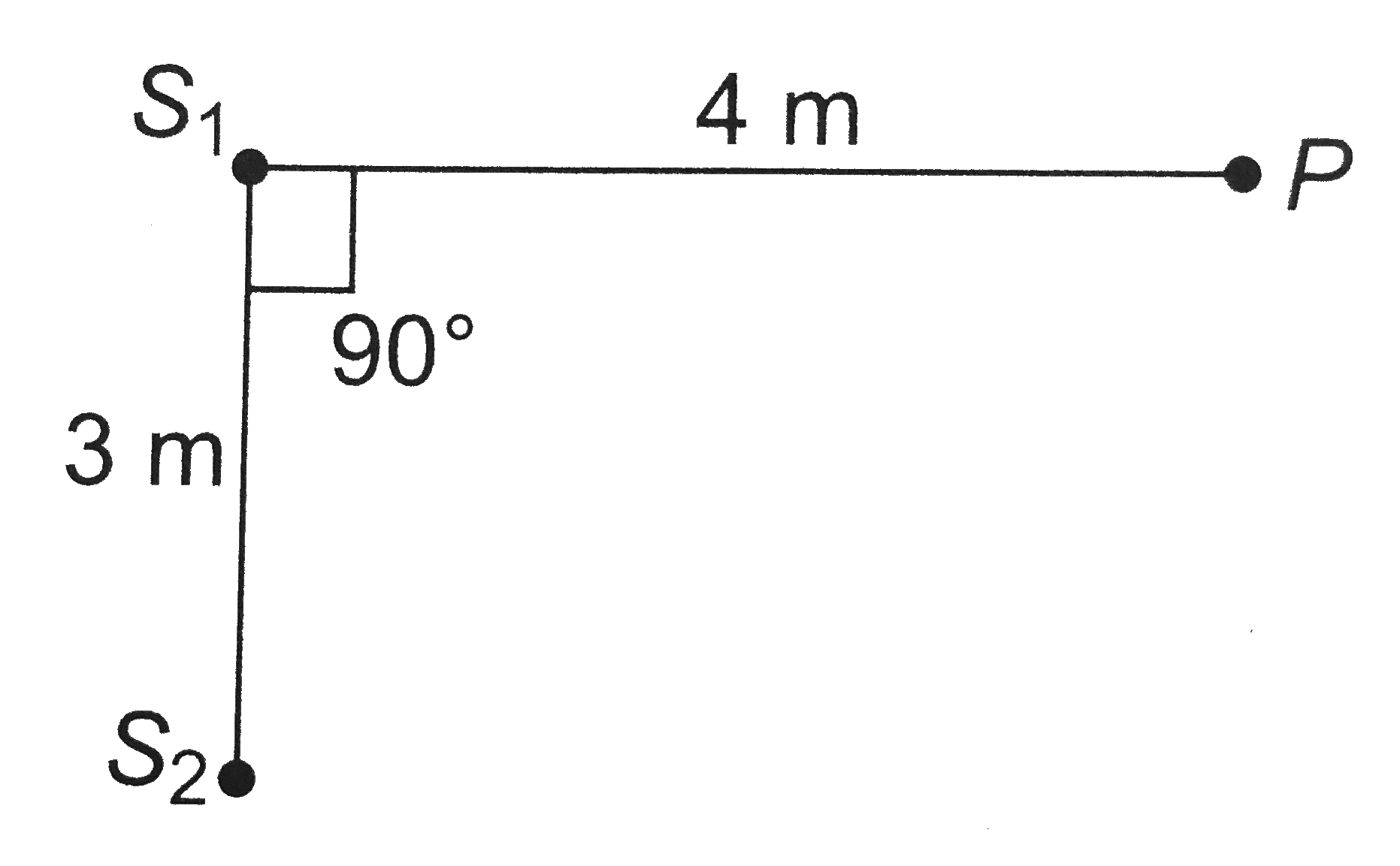At two points S1 and S2 on a liquid surface two coherent wave sources are set in motion at t = 0 with the same phase. The speed of the waves in the liquid v = 0.5 m/s, the frequency of vibration η=5Hz and the amplitude A = 0.04 m. At a point P of the liquid surface which is at a distance x1 = 0.30m from S1 and x2 = 0.34 m from S2 a piece of cork floats:
(a) Find the displacement ofthe cork at t = 3 s.
(b) Find the time t0 that elapse from the moment the wave sources were set in motion until the moment that the cork passes through the equilibrium position for the first time.
The correct Answer is:y=−0.02344m
Path difference between waves at P is
Δ=0.04m
wavelength
λ=vn=0.55 = 0.1m
= 2π×0.04=4π5
The waves from S1 and S2 arrive at point P at different time t1 and t2 given as
= t1=0.30.5 = 0.6s and
t2=0.340.5 = 0.68s
equation of motion of cork it t0=3s is
y=y1+y2
= Asin(ω+t0−t)Asin(ω+(t0−t2))
A[sin(10π(2.4))+Asin(ω(t0−t2))]
= 0.04×sin(23.2π)
= - 0.02344m.
If we consider t = 0 the time when cork starts it motion then the resulting oscillation at cork is given as
y=Asinωt+Asin(ω−4π5)
= Rsin(ωt−θ)
θ=tan−1(Asin(4π/5)A+Acos(π/5))
= 70∘=2π5 rad
Here initial phaseof 70∘ (or2π5rad will be there in cork motion when second wave arrives at it. Thus time after which cork will pass through mean position is given as
t=0.68+π−2π5ω
= 0.68+3π510π
= 0.68 + 0.06 = 0.74s.
Topper's Solved these Questions
- BOOK - PHYSICS GALAXY - ASHISH ARORACHAPTER - WAVES EXERCISE - Practice Exercise 6.410videos
WAVES
- BOOK - PHYSICS GALAXY - ASHISH ARORACHAPTER - WAVES EXERCISE - Practice Exercise 6.516videos
WAVES
- BOOK - PHYSICS GALAXY - ASHISH ARORACHAPTER - WAVES EXERCISE - Practice Exercise 6.211videos
WAVES
- BOOK - PHYSICS GALAXY - ASHISH ARORACHAPTER - WAVE OPTICSEXERCISE - Unsolved Numerical Problems28videos
WAVE OPTICS
- BOOK - PHYSICS GALAXY - ASHISH ARORACHAPTER - X-RAYSEXERCISE - Unsolved Numerica Problem for Preparation23videos
X-RAYS
Similar Questions
A wave of frequency 20 Hz is propagatinig is space with speed 200 m/s. the phase difference of the two points of wave separated by a distance 5 m is
View SolutionTwo coherent sources are at distances x1=0.2m and x2=0.08m from a point. Consider the intensity of resultant wave at that point if the frequency of each wave is f=400Hz and velocity of wave in the medium is V=192m/s
The intensity of each wave is I0=60W/m2View Solution
Knowledge Check
- Question 1 - Select One
A wave of frequency 20 Hz is propagatinig is space with speed 200 m/s. the phase difference of the two points of wave separated by a distance 5 m is
A2π radianBπ radianCπ3 radianDπ2 radian - Question 2 - Select One
A stationary source generates 5.0 Hz water waves whose speed is 2.0 m/s. A boat is approaching the source at 10 m/s. The frequency of these waves, as observed by a person in the boat, is
A25 HzB15 HzC20 HzD30 Hz - Question 3 - Select One
A vibrator generates the waves of the speed 330 m/s and wavelength 0 . 8 m. Then the frequency and time period are
A264 Hz, 0.0037 secB412.5 Hz, 0.0024 secC412.5 Hz, 1.250 secD264 Hz, 0.0030 sec
A point source of light is placed at a depth h=0.5 m below the surface of a liquid (μ=54) , Then , the fraction of light energy that escape directly from the liquid surface is
View Solution
S1 and S2 are two coherent sources of sound of frequency 110Hz each they have no initial phase difference. The intensity at a point P due to S1 is I0 and due to S2 is 4I0. If the velocity of sound is 330m/s then the resultant intensity at P isView SolutionA wave travels at a speed of 0.3 m s−1 and the frequency of wave is 20 Hz. Find the separation between two consecutive compressions.
View SolutionA point source of light is placed at a depth h=0.5 m below the surface of a liquid (μ=54) , Then , the fraction of light energy that escape directly from the liquid surface is
View Solution
S1 and S2 are two coherent sources of sound of frequency 110Hz each they have no initial phase difference. The intensity at a point P due to S1 is I0 and due to S2 is 4I0. If the velocity of sound is 330m/s then the resultant intensity at P isView Solution

